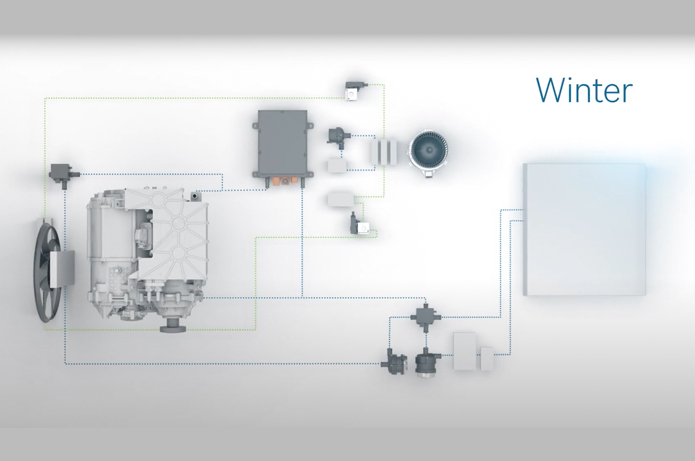Battery cooling in electric vehicles
In electric and hybrid vehicles, battery cooling ensures that the lithium ion batteries are kept within an optimum temperature range.
Function
In order to be able to operate an electric vehicle at high efficiency, it is essential to keep the temperature of the electric motor, power electronics and the battery within an optimum temperature range. As a result, the electric motor and power electronics must be continuously cooled, while the battery has to be either cooled or heated depending on the situation. Temperatures of below 40 °C have to be reached to cool the lithium ion batteries and the power electronics in hybrid and electric vehicles. Achieving this requires a sophisticated thermal management system.
We differentiate between two different types of systems here: a refrigerant based circuit (direct battery cooling) and a cooling and refrigerant based circuit (indirect battery cooling).
Refrigerant based circuit:
The main components that make up the circuit in the refrigerant based system are the condenser, evaporator and battery unit (battery cells, cooling plate and electric auxiliary heater). It is supplied from the air conditioning refrigerant circuit and controlled separately using valves and temperature sensors.
Coolant and refrigerant based circuit:
The more powerful the battery design, the more sense it makes to use a relatively complex coolant and refrigerant based circuit. The entire cooling system is divided into several circuits, each of which has a separate cooler (low temperature cooler), a coolant pump and a coolant shut-off valve. A special heat exchanger, known as the chiller, incorporates the air conditioning refrigerant circuit. A high voltage coolant heater ensures sufficient cooling of the battery at low external temperatures.
The temperature of the coolant for the electric motor and the power electronics is maintained at less than 60 °C in a separate circuit using a low temperature cooler. To achieve full power and the longest possible service life, the coolant temperature for the battery must always be kept between 15 °C and 30 °C. If the temperature is too low, the coolant is heated using a high voltage auxiliary heater. If the temperature is too high, the coolant is cooled down using a low temperature cooler. If this is not sufficient, the chiller - which is integrated into both the coolant and the refrigerant circuit - is used to further cool down the coolant. The refrigerant from the air conditioning flows through the chiller and further cools down the coolant, which is also flowing through the chiller. Thermostats have generally been replaced by electronic control units as the control components, measuring the temperatures using sensors and then taking appropriate control action using the actuators (pumps, valves).
Battery cooling:
Battery segments and cooling plates form a permanently connected battery module. One battery segment is located on each side of the cooling plates. With direct battery cooling, refrigerant from the air conditioning flows through the cooling plates. With indirect battery cooling, coolant flows through the cooling plates. If the cooling capacity is not sufficient with indirect cooling of the battery, the coolant can be additionally cooled down using a chiller.





